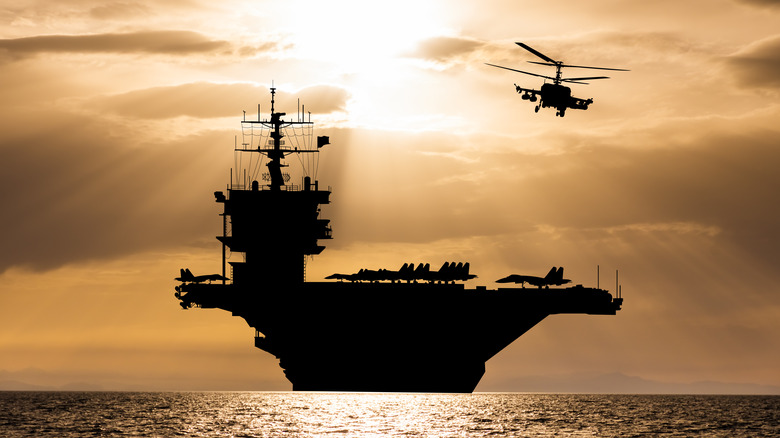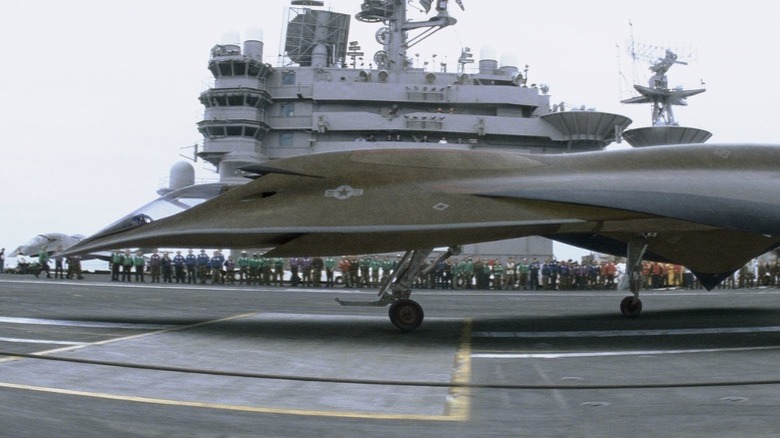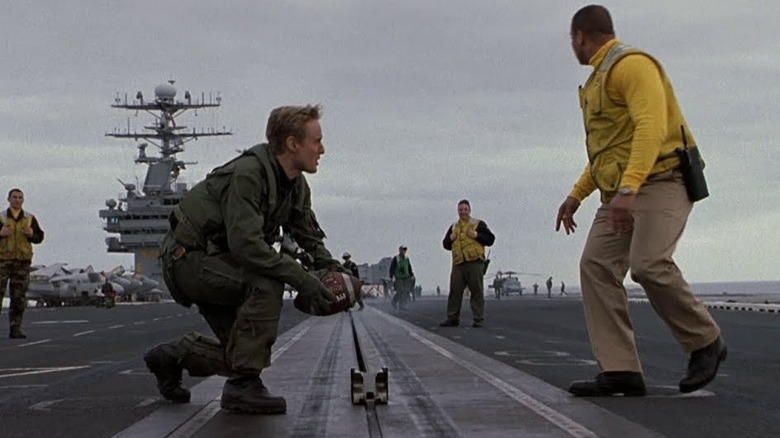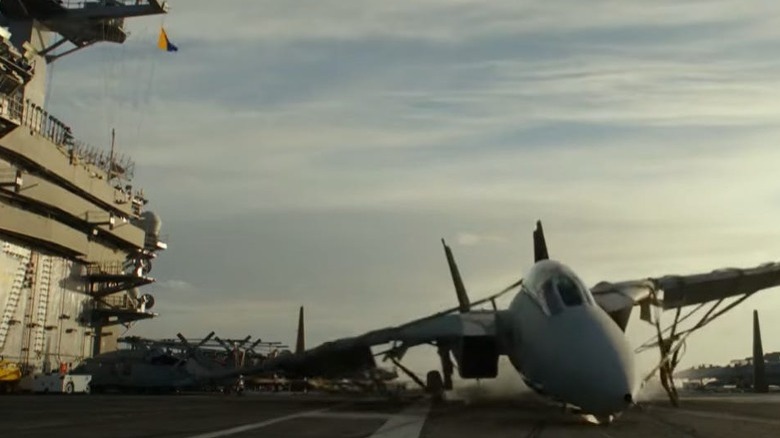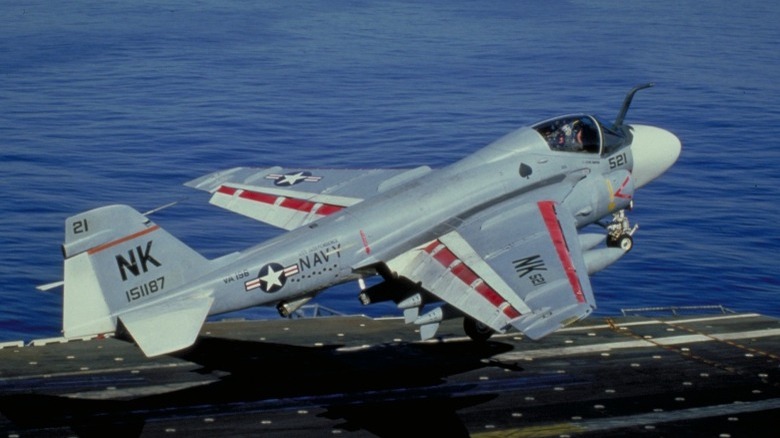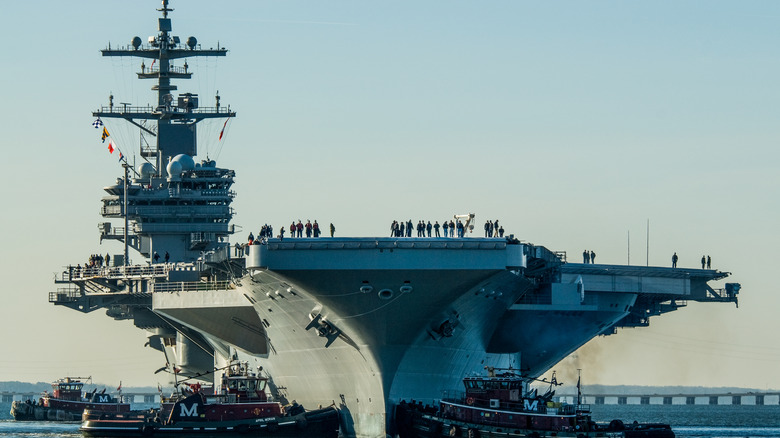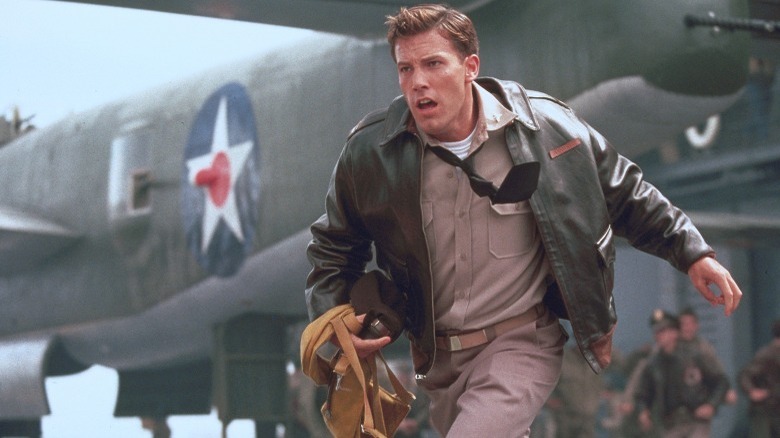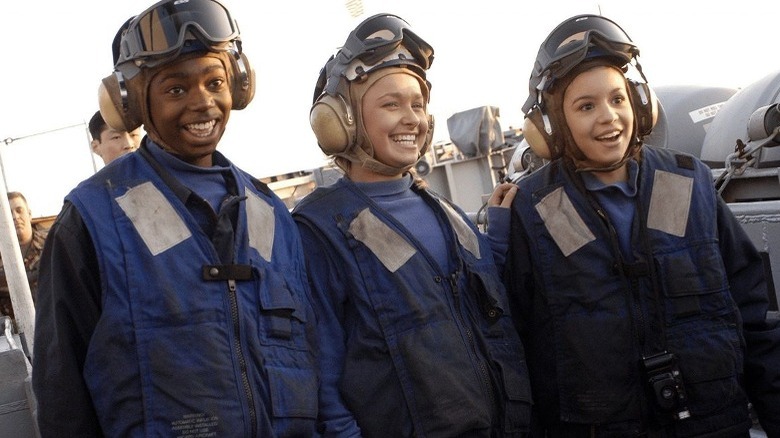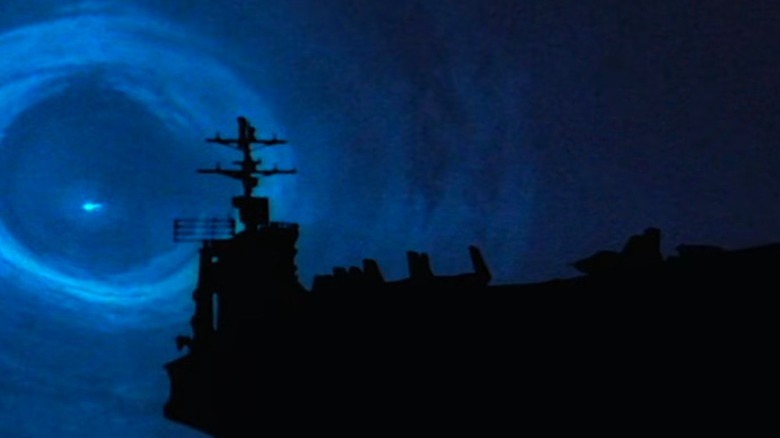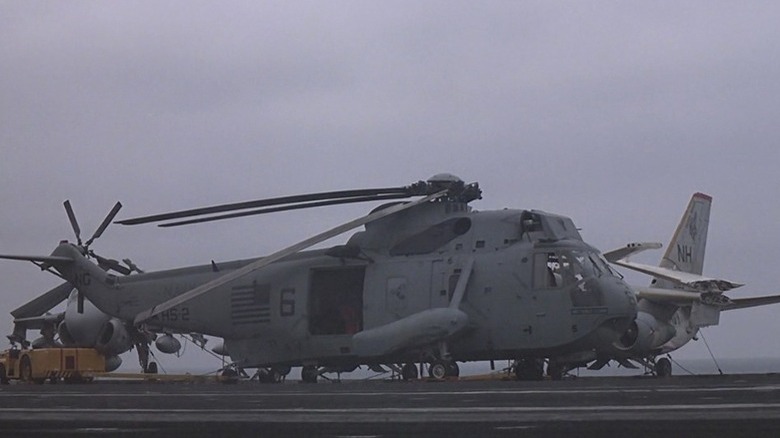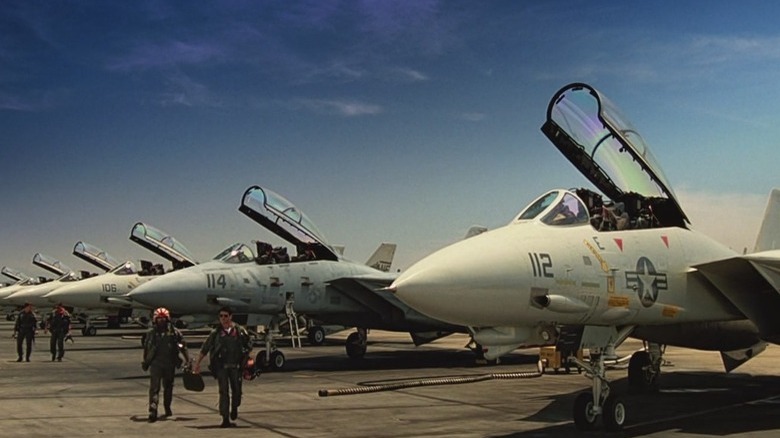10 Movies That Filmed Scenes On Aircraft Carriers
Any action film that features naval forces or fighter jets striking at enemies over sea will invariably also involve an aircraft carrier. These massive vessels act as floating runways, allowing a variety of aircraft to take-off and land without the need for a traditional base. They have become an essential part of militaries around the world and can often be seen in war movies as a result, with dramatic footage depicting fighter jets and bombers launching into the air becoming something of a staple of the genre.
Of course, the sheer size of these ships makes it impractical to build sets to replicate them. The biggest aircraft carriers can be over a thousand feet long and displace more than 100,000 tons when fully loaded. Sometimes it is easier and cheaper to use a real-life aircraft carrier for filming. Fortunately for movie studios, the U.S. Navy and other military forces from across the globe are willing to allow directors to shoot movie scenes on their ships in exchange for financial compensation and exposure.
Here are some of the Hollywood films that have filmed scenes aboard aircraft carriers, capturing footage directly at sea.
Stealth (2005)
"Stealth" is a war film that many people might not know exist. A financial flop, the 2005 release put Jamie Foxx, Jessica Biel, and Josh Lucas into the roles of three pilots, who are part of a team training an unmanned aircraft to fly missions. This advanced stealth jet is intended to strike targets without being seen and without the need to put human pilots in danger. However, things go wrong when the artificial intelligence controlling the aircraft becomes sentient, prompting it to strike out on its own. This prompts a dogfight with the training pilots and a wider escalation of conflict, although the AI eventually comes to regret its actions and sacrifices itself.
The USS Carl Vinson was used early on in production for filming, with some 20 cast and crew shooting scenes on the aircraft carrier for around a week in 2004. The ship was specifically chosen by Columbia Pictures because the naval crew had experience working with filmmakers. Production involved everything from capturing footage of fighter jets taking off and landing in addition to filming the sailors going about their daily duties for background footage. Later in the same year, a larger film crew was welcomed aboard the USS Abraham Lincoln as well as the stealth jet prop seen in the movie.
Behind Enemy Lines (2001)
Owen Wilson might not be the first name that jumps to mind when thinking of action movie stars, but he was cast in the 2001 war film "Behind Enemy Lines" alongside Gene Hackman and Joaquim de Almeida. Co-written by Zak Penn and directed by John Moore, the movie follows Wilson's character, U.S. Navy helicopter pilot Lt Chris Burnett, as he is tasked with observing the NATO peace treaty during the Bosnian War. Shot down by Serbian forces who he witnesses committing genocide, he is pursued by troops behind enemy lines while awaiting rescue. Meanwhile, Rear Adm. Leslie McMahon Reigart (Hackman), in charge of the carrier group where Burnett is stationed, struggles to convince his superiors to pursue a rescue mission behind enemy lines.
Although most of the action in "Behind Enemy Lines" takes place on the ground, there are a number of scenes on aircraft carriers showing jets taking off and landing as well as the scenes featuring Reigart. Fortunately, these sequences look pretty good as the U.S. Navy allowed the film crew to operate aboard the Nimitz-class USS Carl Vinson and Kitty Hawk-class USS Constellation while the two ships were taking part in training exercises in Southern California. This meant the crew had to take special care with fighter jets constantly launching from the ships as the cameras rolled.
Top Gun: Maverick (2022)
The financial success of "Top Gun" always made it a likely candidate for a sequel. However, few would have guessed it would take well over 30 years to see Pete "Maverick" Mitchell on the big screen again. Tom Cruise returned, as did Val Kilmer, while Miles Teller, Jennifer Connelly, Ed Harris, and Jon Hamm all joined as new cast. Set more than three decades after the events of the original "Top Gun," the sequel follows Maverick, who is working as a test pilot. After getting into hot water, he is brought back to train a new group of pilots, including the son of his deceased co-pilot Goose. He has to prepare them for a dangerous mission.
Just like with its predecessor, the filmmakers worked with the Navy for access to weapons, vehicles, and expertise to make the movie as realistic and thrilling as possible. This included allowing the "Top Gun: Maverick" crew to film on an aircraft carrier, specifically the USS Abraham Lincoln. This ship is a Nimitz-class nuclear powered aircraft carrier. Some scenes also filmed aboard the USS Theodore Roosevelt, sister ship to the USS Abraham Lincoln.
"The Navy is supporting one shoot this week aboard USS Abraham Lincoln, per a Production Assistance Agreement signed by Paramount (Pictures) and the Department of Defense," spokesperson Lt. Cdr. Daniel Day told CNN. "Our priority will always be warfighting, and training combat-ready Naval aviation forces ... That being said, we believe we can support the film and simultaneously achieve training objectives."
Flight of the Intruder (1991)
"Flight of the Intruder" is not exactly a popular movie. It grossed under $15 million and was lambasted by critics, and quickly faded from memory. It was directed by John Milius, who wrote for films such as "Dirty Harry," "Apocalypse Now" and "Conan the Barbarian," it features Danny Glover, Willem Dafoe, and Brad Johnson as the commander of a flight squadron and two U.S. Navy pilots operating from the USS Independence during the Vietnam War. Frustrated with a lack of progress and attacks from enemy forces, Dafoe's and Johnson's characters launch their own secret mission deep into Hanoi.
The movie was only made possible because the U.S. Navy agreed to cooperate in almost every aspect of filming, and it did so with full script approval. The branch gave access to several A-6 Intruder bombers, used by the pilots throughout the film, as well as the ability to film in naval facilities, and use the USS Independence. A Forrestal-class aircraft carrier, the USS Independence entered service in 1959. It was used for external shots of the carrier as well as scenes featuring the flight deck and ready room.
Mission: Impossible – Dead Reckoning Part Two (2025)
Although the eighth "Mission Impossible" film still doesn't officially have a title, it is likely to go under the moniker "Mission: Impossible – Dead Reckoning Part Two" given the naming convention of its predecessor. What little we know about the film suggests that it will be a continuation of the story and will feature much of the same cast as Christopher McQuarrie's "Mission: Impossible – Dead Reckoning Part One." That includes the likes of Tom Cruise, Hayley Atwell, Simon Pegg, and Ving Rhames on the big screen as their familiar characters in 2025.
While there isn't a lot of information about the plot, some information has been revealed, which mention the fact that Cruise and the crew have been on an aircraft carrier. A report from Variety, which spoke to the head of the Apulia Film Commission Antonio Parente, revealed that Cruise and the crew were filming on a U.S. Navy aircraft carrier off the coast of Italy. According to Parente, the vessel in question "is probably the U.S.S. George H.W. Bush" — the final Nimitz-class nuclear powered aircraft carrier. What was filmed on the ship is still unknown but the shoot was expected to last around a week.
Pearl Harbor (2001)
With an ensemble cast that includes everyone from Ben Affleck and Kate Beckinsale to Cuba Gooding Jr. and Alec Baldwin, "Pearl Harbor" is a 2001 romance war film loosely tied to a historical event. The attack on Pearl Harbor stands as one of the most important air battles in military history, and the movie doesn't ignore its significance. Of course, it also contains lots of spectacular shots and action packed sequences of the kind you'd expect from a Michael Bay movie. Aircraft carriers, fighters and bombers, and other naval vessels appear frequently — with the attack and the aftermath showcased in the second half of the film — meaning a lot of different filming locations were necessary.
The USS Lexington was used throughout filming for scenes featuring aircraft carriers. It was used to represent the USS Hornet in the movie as well as an unnamed Japanese aircraft carrier. A museum ship that was used to display aircraft, it was renovated to make it look more like a World War II-era ship, including removing the original aircraft and adding period-appropriate fighters and bombers. The ship remained open to the public for at least some of the production, although sets being used for filming locations were closed off.
Tiger Cruise (2004)
Bill Pullman and Hayden Panettiere are the main protagonists in this 2004 film. Created for the Disney Channel, Pullman and Panettiere play father and daughter aboard the aircraft carrier USS Constellation. Commander Gary Dolan is a senior officer of the ship while Maddie Dolan is his daughter, who wants her dad to spend more time with the family. The story sees the ship operating as a tiger cruise, where civilians such as family members join the crew to get a taste of what life is like at sea. Just a day into the cruise, though, word reaches the carrier about the 9/11 terrorist attacks and the families have to deal with the realization that the military will be entering a period of increased activity.
With the action taking place almost exclusively aboard the USS Constellation, it makes sense that the crew would want to secure real-life aircraft carriers for filming purposes. The U.S. Navy was prepared to allow the movie to be shot on both the USS John C. Stennis and USS Nimitz, two Nimitz-class aircraft carriers, giving the film a sense of authenticity. Filming on the naval vessels posed some challenges, with Pullman telling the Associated Press: "You can't shut down the ship and I was so unused to not having complete quiet on the set ... it took me a while to adapt to that."
The Final Countdown (1980)
"The Final Countdown" is a somewhat strange concept for a war film, especially one that features aircraft carriers and other naval vessels. Released in 1980, the Don Taylor-directed film is a science fiction that shows what might be possible with time travel if a modern day aircraft carrier is sent back in time. Kirk Douglas stars in the movie as Capt. Matthew Yelland, the commanding officer of the aircraft carrier USS Nimitz, which is sent back in time a day before the attack on Pearl Harbor. Yelland must grapple with the decision to warn U.S. forces of the impending attack and engage the Japanese fleet or allow history to take place as intended.
Despite being far from a hit both commercially and critically, "The Final Countdown" has become something of a cult classic. This is largely due to the bizarre plot and the fact that it was set and filmed almost entirely on the USS Nimitz, a brand new nuclear powered aircraft carrier. This gave an authentic feeling to life on the ship but also led to some difficulties during production. A camera operator and another member of the film crew were thrown down the runway from the power of a Tomcat engine as it took off and several replica aircraft were almost destroyed. Adding to the realism, though, was the fact that sailors from the aircraft carrier were used as extras and some even appear in the movie's credits.
The Hunt for Red October (1990)
Based on the Tom Clancy novel of the same name, "The Hunt for Red October" is a 1990 spy thriller that sees Sean Connery take on the role of the Lithuanian-born Capt. Marko Ramius and Alec Baldwin as CIA analyst Jack Ryan. The story focuses on the Red October, a Soviet vessel that uses innovative stealth technology that makes it practically impossible to track. This makes it a huge threat to peace and one of the best submarines of the Cold War. Wanting to prevent the Soviet Union from having a way to secretly launch nuclear weapons against the United States, Ramius attempts to defect and hand over the technology to U.S. authorities.
As most of the action happened on submarines, and it was impractical to film on underwater vessels, the crew had to construct sets for the three main submarines featured in the movie. But that doesn't mean that no real ships were used in the shooting of The Hunt for Red October." Keen to see a similar effect to what "Top Gun" had with recruitment in the U.S. Air Force, officials from the U.S. Navy approved the use of several real-life craft. This included the aircraft carrier USS Enterprise, where some exterior shots were filmed, as well as several frigates and the submarine USS Houston. Behind-the-scenes footage even shows some filming on the flight deck of the vessel.
Top Gun (1986)
For many, " Top Gun" is the quintessential combat action film. The 1986 movie was directed by Tony Scott and stars Tom Cruise as Navy Lt. Pete "Maverick" Mitchell. Young and brash, Maverick is stationed aboard the USS Enterprise along with his radar officer Lt. Nick "Goose" Bradshaw. However, the pair soon end up in San Diego, California, when they are picked to hone their skills at the elite Fighter Weapons School — otherwise known as Top Gun. Determined to be ranked as the top pilot in the program, Maverick clashes with the likes of Val Kilmer's Iceman. While it didn't fare particularly well with critics, "Top Gun" proved to be a financial success, grossing over $350 million.
While it is the fighter jets that steal the show in "Top Gun," the USS Enterprise is featured prominently throughout the film. Maverick is first shown flying as part of the USS Enterprise flight crew and at the closing moments of the movie, he takes off from the aircraft carrier to battle against a squadron of MiGs. Action of the flight crew during its normal operational duties was filmed on the actual USS Enterprise, as were shots of the fighter jets taking off for the dramatic dogfight at the. In fact, director Scott had to pay $25,000 to change the direction of the aircraft carrier so that the crew could keep filming when the light changed.
The cast and crew even filmed promotion interviews for the film's release on the USS Enterprise in November 1985. Other aircraft carriers were used for interior shots as the USS Enterprise was not always available or suitable for filming. These included both the USS Ranger— built in the 1950s — and the Nimitz-class aircraft carrier USS Carl Vinson.
